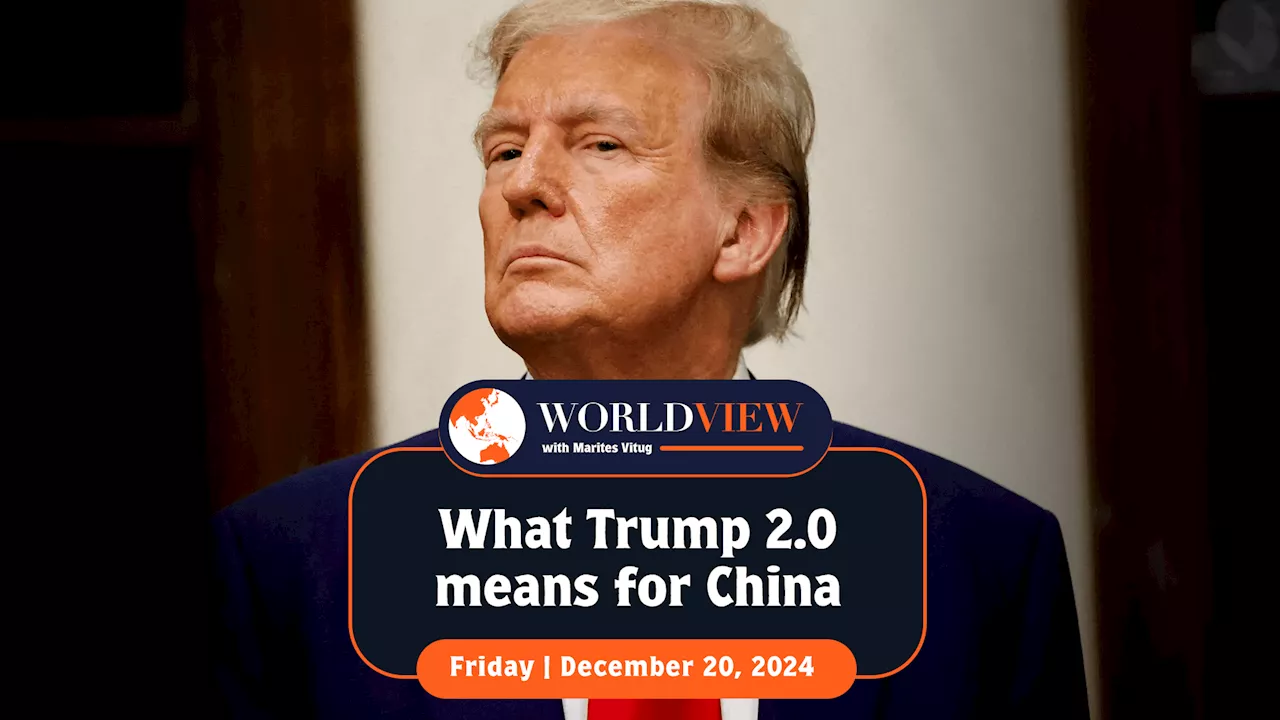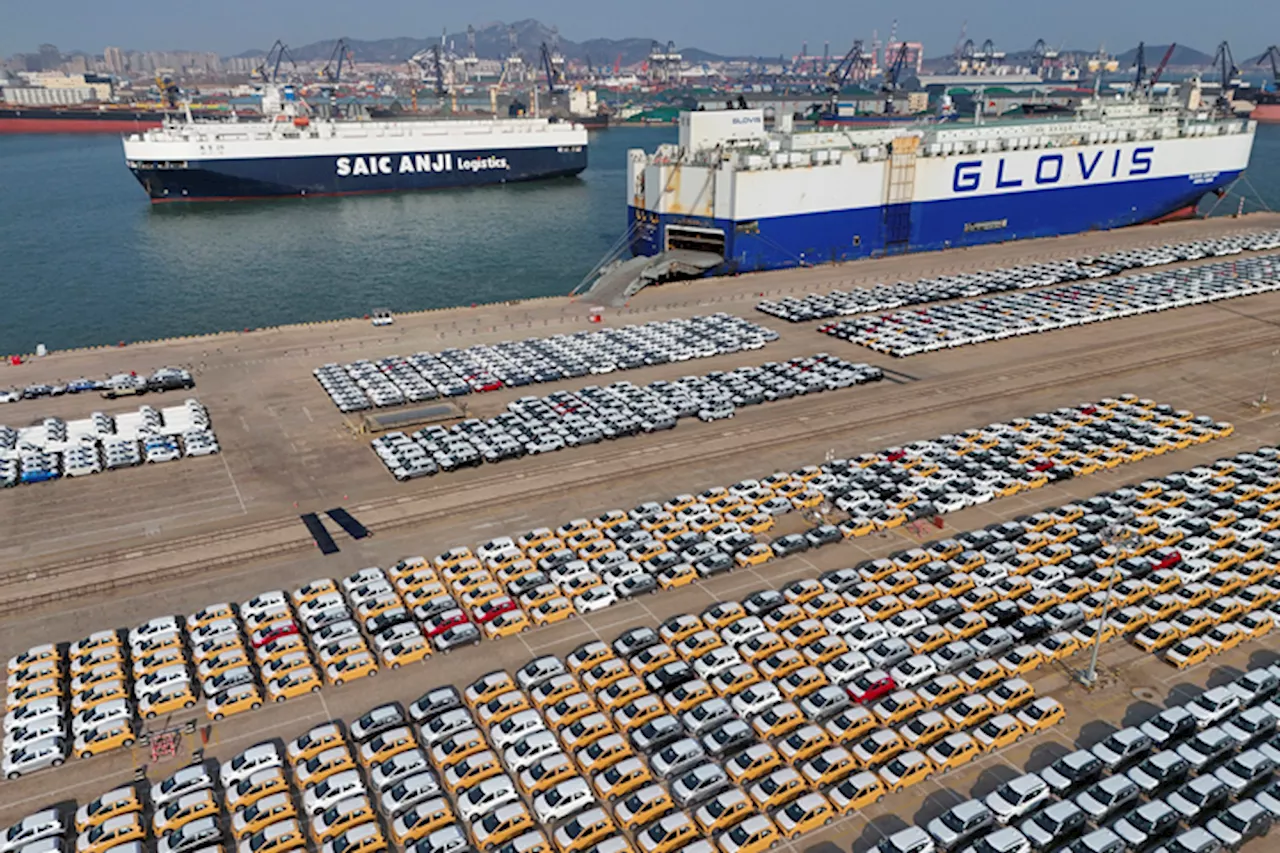China's exports grew at a faster pace than expected in December, fueled by businesses rushing to fulfill orders ahead of potential tariff hikes by the incoming US administration. This surge in exports, coupled with a modest increase in imports, resulted in a substantial trade surplus.
Vehicles and trucks for export wait for transportation from a port in Yantai in eastern China’s Shandong province on Jan. 2, 2025. China’s exports in December grew at a faster pace than expected, as factories rushed to fill orders to beat higher tariffs that US President-elect Donald Trump has threatened to impose once he takes office. Exports rose 10.7 percent from a year earlier. Economists had forecast they would grow about 7 percent. Imports rose 1 percent year-on-year.
Analysts had expected them to shrink about 1.5 percent. With exports outpacing imports, China’s trade surplus grew to $104.84 billion.Trump has pledged to raise tariffs on Chinese goods and close some loopholes that exporters now use to sell their products more cheaply in the US. If enacted, his plans would likely raise prices in America and squeeze sales and profit margins for Chinese exporters. China’s exports are likely to remain strong in the near-term, said Zichun Huang of Capital Economics, as businesses try to “front-run” potentially higher tariffs. “Outbound shipments are likely to stay resilient in the near-term, supported by further gains in global market share thanks to a weak real effective exchange rate,” she wrote in a note. But exports will likely weaken later in the year if Trump follows through on his threat to impose tariffs, Huang said.Officials who briefed reporters in Beijing said the total value of China’s imports and exports reached a record 43.85 trillion yuan (nearly $6 trillion), up 5 percent from a year earlier. China is the world’s largest exporter and the main trading partner of more than 150 countries and regions, said Wang Lingjun, the Customs Administration’s deputy director general. While growth of the rest of China’s economy has slowed following the pandemic and partly because of downturn in the housing industry, exports have surged. Under leader Xi Jinping, the ruling Communist Party is promoting upgrading of factories and a shift to more high-tech manufacturing. The report Monday said China’s export of mechanical and electrical products increased by almost 9 percent last year from a year earlier, with growth in exports of “high-end equipment” jumping more than 40 percent. Exports of electric vehicles rose 13 percent, exports of 3D printers jumped almost 33 percent and shipments of industrial robots surged 45 percent. E-commerce trade, including sales by companies including Temu, Shein and Alibaba, registered 2.6 trillion yuan ($350 billion), more than twice the level in 2020.China does not pursue a trade surplus and wants to increase its imports, the officials said. But while imports edged higher last year, they still lagged exports, partly due to lower prices for key commodities such as oil and iron ore. “Regarding this year’s imports, we believe that there is still a lot of room for growth. This is not only because my country’s market capacity is large, there are many levels, and it has huge potential,” said Lv Daliang, a Customs Administration spokesperson. China also is blocked from importing some products due to trade restrictions, Lv said, alluding to controls by the US and some other countries on strategically sensitive exports to China, such as sales of advanced semiconductors and items that can be used for military purposes. “In addition, some countries politicize economic and trade issues, abuse export control measures, and unreasonably restrict the export of some products to China, otherwise we will import more,” he said.The officials emphasized China’s efforts to expand trade with countries participating in its “Belt and Road” initiative to expand infrastructure construction and trade across much of the globe. Trade with those countries accounted for about half of China’s total trade last year. They noted that China has completely eliminated tariffs on imports from the world’s poorest countries. But China also values trade with traditional markets like Europe and the United States, and two-way trade with the US grew nearly 5 percent last year. “We imported agricultural products, energy products, medicines, and aircraft from the United States, and exported clothing, consumer electronics, and household appliances to the United States, achieving mutual benefit and win-win results,” Wang said.US officials and other critics say Beijing has pushed an expansion of exports to help make up for sluggish demand inside China as the economy has slowed. With factories in some industries operating well below capacity, they contend that the country has an “overcapacity” problem.“Whether from the perspective of comparative advantage or global market demand, there is no so-called ‘China’s overcapacity’ problem. This problem is a pure false proposition,” Wang said when asked about the issue. China has made its industries more efficient through upgrading, investment and innovation supported by research and development, he said
CHINA EXPORTS TARIFFS TRADE SURPLUS US-CHINA RELATIONS GLOBAL ECONOMY
Philippines Latest News, Philippines Headlines
Similar News:You can also read news stories similar to this one that we have collected from other news sources.
 Philippines Pineapple Exports to Surge 16% in 2024The Philippines is set to see a significant increase in its pineapple exports this year, driven by strong demand from key markets like China, Japan, and Korea. According to the Food and Agriculture Organization of the United Nations (FAO), exports are projected to reach 692,365 metric tons, up 16% from the previous year.
Philippines Pineapple Exports to Surge 16% in 2024The Philippines is set to see a significant increase in its pineapple exports this year, driven by strong demand from key markets like China, Japan, and Korea. According to the Food and Agriculture Organization of the United Nations (FAO), exports are projected to reach 692,365 metric tons, up 16% from the previous year.
Read more »
 HEADLINES: China warns PH, slams US | December 15, 2024Good day. Here are the stories for The Manila Times for Sunday, December 15, 2024.
HEADLINES: China warns PH, slams US | December 15, 2024Good day. Here are the stories for The Manila Times for Sunday, December 15, 2024.
Read more »
 Australia's Budget Forecast to Widening Deficit Amid Spending Surge and China's SlowdownAustralia's budget is projected to worsen in the coming years, driven by increased government spending and a slowdown in China's economy, according to a mid-year fiscal update. Although the deficit is expected to contract slightly in the current fiscal year, it is predicted to swell to A$46.9 billion in 2025-26, posing a challenge for Treasurer Jim Chalmers ahead of the national election.
Australia's Budget Forecast to Widening Deficit Amid Spending Surge and China's SlowdownAustralia's budget is projected to worsen in the coming years, driven by increased government spending and a slowdown in China's economy, according to a mid-year fiscal update. Although the deficit is expected to contract slightly in the current fiscal year, it is predicted to swell to A$46.9 billion in 2025-26, posing a challenge for Treasurer Jim Chalmers ahead of the national election.
Read more »
 DOH Rules Out Lockdowns Amid HMPV Surge in ChinaThe Department of Health (DOH) has dismissed the possibility of imposing lockdowns or border closures in response to a surge in human metapneumovirus (HMPV) cases in China.
DOH Rules Out Lockdowns Amid HMPV Surge in ChinaThe Department of Health (DOH) has dismissed the possibility of imposing lockdowns or border closures in response to a surge in human metapneumovirus (HMPV) cases in China.
Read more »
 DOH allays fears on respiratory virus surge in China, says no cause for alarmAmid reports on the alleged surge in the number of people with respiratory virus transmission in China, the Department of Health (DOH) on Wednesday reiterated the clarification of the World Health Organization (WHO), particularly on the Human metapneumovirus (hMPV), saying that the upward trend is expected during the winter...
DOH allays fears on respiratory virus surge in China, says no cause for alarmAmid reports on the alleged surge in the number of people with respiratory virus transmission in China, the Department of Health (DOH) on Wednesday reiterated the clarification of the World Health Organization (WHO), particularly on the Human metapneumovirus (hMPV), saying that the upward trend is expected during the winter...
Read more »
 US-China Relations: Challenges for China in the Next Four YearsJoin Rappler editor-at-large Marites Vitug and UP Diliman political science associate professor Jan Robert Go for a discussion on the future of US-China relations under a second Trump administration.
US-China Relations: Challenges for China in the Next Four YearsJoin Rappler editor-at-large Marites Vitug and UP Diliman political science associate professor Jan Robert Go for a discussion on the future of US-China relations under a second Trump administration.
Read more »
